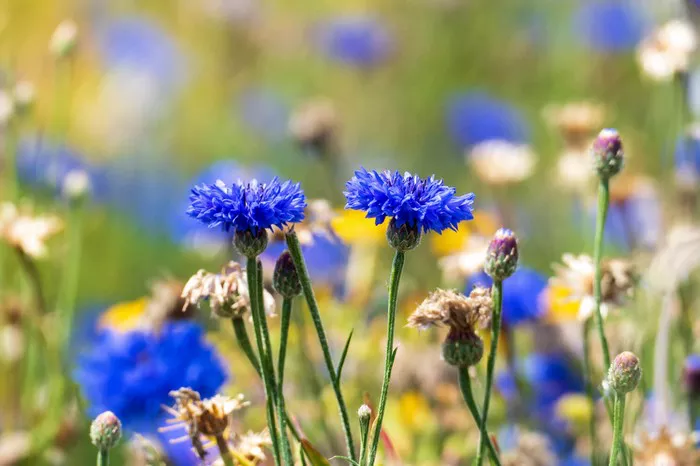When it comes to adding a touch of natural elegance to your garden or landscape, few flowers can compare to the striking beauty of cornflowers. Also known as Centaurea cyanus, these delightful blooms are renowned for their vibrant colors, easy cultivation, and versatility in various garden settings. Whether you’re an experienced gardener or a novice looking to add some charm to your outdoor space, this guide on how to grow cornflowers will provide you with all the essential information you need to cultivate these enchanting flowers successfully.
1. Selecting the Right Cornflower Varieties
Before you start growing cornflowers, it’s crucial to choose the right variety for your garden. There are several different types of cornflowers available, each with its unique characteristics and colors. Some popular varieties include:
Classic Blue Cornflowers
The classic blue cornflower, with its vibrant royal blue petals and contrasting dark centers, is perhaps the most well-known variety. These traditional cornflowers are perfect for adding a splash of color to any garden or floral arrangement.
Pink Cornflowers
Pink cornflowers, also known as bachelor’s buttons, offer a softer and more delicate appearance. Their lovely pink hues make them a popular choice for romantic garden settings.
White Cornflowers
White cornflowers exude an air of purity and elegance. They are often used in wedding bouquets and arrangements, symbolizing purity and innocence.
Mixed Varieties
If you can’t decide on a single color, consider planting a mix of cornflower varieties. This can create a vibrant and visually appealing garden bed with a range of colors and textures.
2. Choosing the Right Location and Soil for Cornflowers
Sunlight Requirements
Cornflowers thrive in full sunlight, so it’s essential to choose a location in your garden that receives at least 6 to 8 hours of direct sunlight each day. These plants are not shade-tolerant and may become leggy and less robust if they don’t receive adequate sunlight.
Well-Drained Soil
Cornflowers prefer well-drained soil with good aeration. They are relatively adaptable and can grow in a variety of soil types, but they do best in soil that is slightly alkaline. If your soil is heavy or clay-like, consider amending it with organic matter, such as compost, to improve drainage.
3. Planting Cornflowers
Sowing Seeds
Cornflowers can be grown from seeds, making them an accessible option for all gardeners. The best time to sow cornflower seeds is in early spring or late fall. Simply scatter the seeds on the prepared soil surface and lightly press them into the soil with your hand or a garden tool. Water the area gently to settle the seeds.
Spacing and Depth
When sowing cornflower seeds, ensure proper spacing. Plant the seeds about 6 to 12 inches apart to provide enough room for the mature plants to grow. The depth should be shallow, no more than 1/4 inch deep. Cornflower seeds require light for germination, so they should not be buried too deeply.
4. Caring for Your Cornflowers
Watering
Cornflowers are relatively drought-tolerant once established, but they still require consistent moisture during their early growth stages. Water them thoroughly when the soil feels dry to the touch. Avoid overwatering, as this can lead to root rot.
Fertilizing
Cornflowers generally do not require heavy fertilization. Too much nitrogen can result in excessive foliage growth at the expense of flower production. A balanced, slow-release fertilizer applied in the spring should be sufficient to support healthy growth and blooming.
Deadheading
To encourage continuous blooming, deadhead your cornflowers regularly. Deadheading involves removing faded or spent blooms by pinching them off at the stem. This practice redirects the plant’s energy into producing more flowers, extending the blooming season.
Pest and Disease Management
Cornflowers are relatively resistant to pests and diseases, but they can occasionally be affected by aphids, powdery mildew, or rust. Inspect your plants regularly and treat any issues promptly with appropriate organic or chemical remedies, if necessary.
Supporting Tall Varieties
Taller varieties of cornflowers may benefit from staking or providing support as they grow. This prevents them from flopping over and breaking under the weight of their blooms. Use stakes or plant supports that blend seamlessly with your garden design.
5. Harvesting Cornflowers
Timing
The timing of your cornflower harvest depends on your intended use. For fresh flower arrangements, cut the blooms when they are fully open but before they start to fade. If you want to collect seeds for the next season, allow some of the flowers to mature fully on the plant.
Cutting Technique
When harvesting cornflowers for arrangements, use sharp scissors or pruning shears to make clean cuts. Cut the stems at an angle, and place the freshly cut stems in a bucket of water immediately to prevent wilting.
Drying Cornflowers
To dry cornflowers for crafts or floral arrangements, bundle several stems together and hang them upside down in a cool, dry, and dark place. The flowers will retain their color and shape as they dry.
Conclusion
Growing cornflowers can be a rewarding experience, adding beauty and charm to your garden while attracting beneficial pollinators. By selecting the right varieties, providing optimal growing conditions, and following proper care and maintenance, you can enjoy a vibrant display of these stunning blooms season after season. Whether you’re cultivating them for their captivating colors or as a symbol of nature’s beauty, cornflowers are a delightful addition to any garden. So, roll up your sleeves, prepare your garden bed, and start your journey to grow cornflowers that will brighten your outdoor space and bring joy to your heart.


